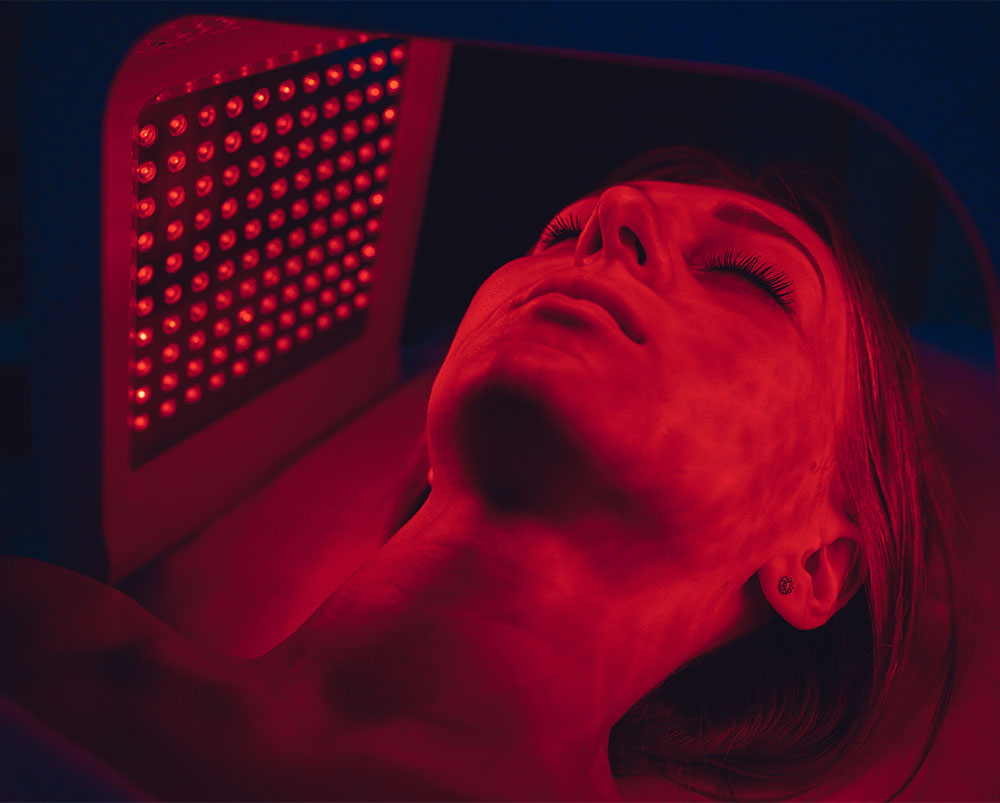Have you ever heard of red light phototherapy? It's a cutting-edge treatment that has been gaining popularity in recent years for its ability to improve skin, reduce inflammation, and even promote weight loss. In this comprehensive guide, we will take you on a journey through the history of red light therapy and unravel the science behind it. We will also take a closer look at the different types of red light therapy available and examine whether or not it can help with weight loss and sleep quality. Plus, we'll provide tips on how to safely and effectively do DIY red light therapy at home. By the end of this guide, you'll be armed with all the information you need to make an informed decision about whether or not red light therapy is right for you.
Who Invented Red Light Therapy?
Red Light Therapy, also known as photobiomodulation, has been studied and used for various health and wellness purposes. While it is difficult to attribute the invention of Red Light Therapy to a single individual, its origins can be traced back to scientific research and discoveries in the field of light therapy.
In the late 1960s, scientists began conducting studies on the effects of red and near-infrared light on cells and tissues. One notable researcher in this field is Dr. Endre Mester, a Hungarian physician who conducted early experiments with low-level laser therapy (LLLT) using red light.
Over the years, researchers and medical professionals have continued to study and refine the use of red light for therapeutic purposes. Today, Red Light Therapy is widely used in various industries, including medicine, skincare, and sports performance.
Unraveling the Concept of Red Light Phototherapy
Enhancing tissue repair and healing, red light therapy offers potential benefits for various conditions. It improves blood flow, rejuvenates skin, and aids wound healing. Utilized in treatment devices, its effectiveness is supported by clinical trials. Laser therapy, photodynamic therapy, and photobiomodulation therapy are some types of light-based treatments often used in dermatologist’s offices and dental offices. Human studies have shown promising results in recent years, particularly in the reduction of fine lines. A small study at the Cleveland Clinic revealed positive outcomes for carpal tunnel syndrome.

A Glimpse into the History of Red Light Therapy
Dating back to ancient civilizations, light therapy has evolved significantly with new research and technology. Initially utilized for wound healing and tissue repair, it has gained popularity for skin rejuvenation in recent years. Its historical effectiveness has been validated by human studies, making it a widely accepted form of treatment. From small published studies to the endorsement of dermatologists and associate professors, red light therapy has made its mark in medical practices and is increasingly being incorporated into various healthcare treatments.
The Science Behind Red Therapy Lights
The body's cells are stimulated by red light therapy to produce adenosine triphosphate, promoting collagen production and skin rejuvenation. Different wavelengths of light impact skin tissue and conditions, with enough evidence for effectiveness. Moreover, potential benefits for brain disorders and sports performance have been observed. This therapy has also shown promise in small human studies for conditions like carpal tunnel syndrome and hair loss. In recent years, published studies have further substantiated the positive effects of this type of light therapy on various health aspects.
Red Light and Blue Light Therapy
The benefits of red and blue light therapy for skin concerns have been validated through controlled trials, showing their effectiveness. Blue light therapy complements red light therapy for specific conditions, and treatment options include additional wavelengths of visible light. The type of photomedicine used determines the effectiveness of the therapy. Incorporating various NLP terms like photobiomodulation therapy, human studies, and reduction of fine lines adds depth to the understanding of light therapy advancements in recent years. Laser therapy and its effectiveness in treating carpal tunnel syndrome or hair loss showcase the diverse applications of light therapy.

The Dualism of Red and Blue Light Therapy
In the realm of light therapy, red light focuses on reducing skin roughness and fine lines, accelerating recovery, and enhancing skin tissue repair. On the other hand, blue light targets specific skin issues and conditions, proving effective for seasonal affective disorder and improving overall skin appearance, including collagen density. The dualism of these therapies presents a holistic approach to addressing a wide range of skin concerns, offering potential benefits for various health conditions and skin rejuvenation, as affirmed by recent studies in the field of photobiomodulation therapy.
How does Blue Light Complement Red Light Therapy?
Blue light is a valuable complement to red light therapy. It effectively addresses skin concerns like acne, skin damage, and cold sores. Research studies have proven its effectiveness in treating various skin conditions. When combined with red light therapy, blue light offers additional benefits for optimal results.
Types of Red Light Therapy: A Closer Look
Exploring the realm of red light therapy unveils various types catering to specific needs. Infrared light therapy delves deep, targeting tissue repair and rejuvenation. Meanwhile, LED red light therapy stands out for its prowess in skin and hair wellness. Varied light wavelengths address distinct skin concerns, offering tailored treatment options for diverse needs. Furthermore, the satisfaction derived from red light devices in medical settings underscores their effectiveness in delivering results. The diverse array of red light therapy types caters to a spectrum of health and wellness needs with confidence and efficacy.

Infrared Light Therapy Treatment
Infrared light therapy treatment delves deeper into skin tissue, offering potential benefits for hair growth and weight loss. It effectively reduces scar tissue, skin damage, and presents new treatment options for various skin conditions. Recent studies stress the therapy's effectiveness, making it a promising option in dermatologist’s offices for the reduction of fine lines. In recent years, human studies have emphasized its potential, leading to its popularity in various health facilities. Its efficacy in addressing carpal tunnel syndrome and its availability in dental offices further highlight its versatility.
LED Red Light Therapy
LED red light therapy harnesses specific wavelengths to stimulate collagen production and accelerate wound healing. Extensive research validates its effectiveness for skin rejuvenation and healing. This type of light therapy offers tailored treatment options for various skin conditions, providing holistic healthcare benefits. Widely available in medical settings, including dental and doctor’s offices, LED red light devices have garnered positive attention in recent years. The therapy's potential to address specific skin concerns and healthcare benefits has been underscored in published studies and human research, firmly establishing its credibility.
Red Light Therapy for Weight Loss: Fact or Fiction?
Is red light therapy effective for weight loss? Discover the potential benefits and effectiveness of red light therapy devices. Learn how it works on a cellular level to boost metabolism and reduce inflammation. Find tips for incorporating red light therapy into your weight loss routine.
Red Light For Sleep
Explore the potential benefits of red light therapy for improving sleep quality and regulating sleep cycles. Discover how red light therapy may enhance blood flow, which could contribute to better sleep. Additionally, investigate the effectiveness of blue light therapy in promoting sleep quality.

DIY Red Light Therapy: Is It Safe and Effective?
Is it safe and effective to try DIY red light therapy? Many DIY red light therapy devices have shown potential benefits for skin rejuvenation. However, it is important to understand the potential risks and take necessary precautions when using a red light device at home.
How to Choose Your Home Red Light Therapy Device
When selecting your home red light therapy device, prioritize specific wavelengths tailored to your treatment needs. Opt for devices backed by clinical trials for safety and efficacy. Choose devices offering treatment options for various conditions, supported by evidence. Ensure the device addresses skin concerns and consider human studies for verification. Embrace photobiomodulation therapy or other advanced types of light therapy for holistic benefits. Before making a purchase, consult a dermatologist or associate professor for guidance. Make an informed decision for your well-being and explore this revolutionary phototherapy option.
What Are the Risks and Precautions When Doing Red Light Therapy at Home?
When doing red light therapy at home, it is important to follow recommended distance and time guidelines. Caution should be exercised for skin damage and skin cancer concerns. Consultation with a healthcare provider is advised for treating specific skin conditions. Be aware of potential side effects.
Before After Red Light Therapy
Red light therapy has gained popularity for its potential benefits in various areas, including skin rejuvenation. But what can you expect before and after undergoing this treatment?
Before Red Light Therapy:
Before starting red light therapy, it is essential to consult with a healthcare provider or dermatologist. They will evaluate your specific needs and determine if red light therapy is suitable for you.
During this consultation, they may discuss any underlying medical conditions or medications that could affect the results of the treatment. It's important to provide accurate information for your safety and the effectiveness of the therapy.
Once you have received the green light from your healthcare provider, you can prepare for your red light therapy session. It is recommended to cleanse your skin thoroughly and remove any makeup or lotions before beginning the treatment. This ensures that the light penetrates your skin more effectively, maximizing its potential benefits.
During Red Light Therapy:
As you settle in for your red light therapy session, you will be exposed to a specific wavelength of light that targets the deep layers of your skin. The duration of each session may vary depending on your specific goals and the device you are using. It is important to follow the instructions provided by your healthcare provider or the manufacturer of the device.
You may be asked to wear protective eyewear to shield your eyes from the bright light. Relax and enjoy the session as the red light works its magic on your skin.
After Red Light Therapy:
After completing a session of red light therapy, you may notice immediate improvements in your skin's texture and appearance. However, it is important to keep in mind that results can vary from person to person.
In some cases, you might experience mild redness or slight sensitivity in the treated area. These side effects are usually temporary and should subside within a few hours. It is recommended to avoid direct sunlight and tanning beds for at least 24 hours after the treatment, as your skin may be more sensitive during this time.
To maintain the benefits of red light therapy, it is suggested to incorporate regular sessions into your skincare routine. Depending on your goals, your healthcare provider may recommend multiple sessions per week or a maintenance plan for long-term results.

What does red light do to your brain?
Red light has been shown to have various effects on the brain. One of the main effects is its ability to stimulate the production of adenosine triphosphate (ATP), which is the energy source for cells. This can help increase cellular metabolism and improve brain function. Additionally, red light therapy has been found to promote the release of nitric oxide, which can increase blood flow and oxygen delivery to the brain. This can enhance cognitive function, memory, and overall brain health. Red light therapy has also been shown to have anti-inflammatory effects, which can help reduce brain inflammation and promote healing after injury or trauma. Overall, while more research is needed, red light therapy shows promise in supporting brain health and function.
Is red light phototherapy suitable for everyone or are there certain conditions that make it unsuitable?
Red light phototherapy is generally considered safe for most people, but there are certain conditions that may make it unsuitable or require precautions. It is always recommended to consult with a healthcare professional before starting any new treatment or therapy.
Some conditions that may make red light phototherapy unsuitable include:
1. Photosensitivity disorders: People with photosensitivity disorders, such as porphyria, should avoid red light therapy as it can exacerbate their condition.
2. Eye conditions: Direct exposure of the eyes to red light can be harmful and may cause damage, so it is important to protect the eyes during treatment.
3. Active skin infections: Red light therapy should not be used on areas of the skin with active infections, as it can potentially worsen the infection.
4. Certain medications: Some medications can increase sensitivity to light or cause other adverse effects when combined with red light therapy. It is important to discuss any current medications with a healthcare professional.
Overall, while red light phototherapy is generally safe and well-tolerated, it is important to consider individual health factors and consult with a healthcare professional before starting any new treatment.
What are the anti-aging benefits of red light therapy?
Red light therapy has been shown to have several potential anti-aging benefits. When applied to the skin, red light stimulates the production of collagen, which is a protein that helps keep the skin firm and elastic. By increasing collagen production, red light therapy can help reduce the appearance of fine lines and wrinkles, improve skin texture, and promote a more youthful appearance.
In addition to collagen stimulation, red light therapy also helps increase blood circulation in the skin, which can deliver more oxygen and nutrients to the cells and promote cell regeneration. This can help improve skin tone and reduce the appearance of age spots or hyperpigmentation.
Red light therapy may also have anti-inflammatory effects, which can help reduce redness or inflammation in the skin caused by conditions like acne or rosacea. It can also help accelerate wound healing and minimize scarring.
Overall, red light therapy offers a non-invasive and painless option for promoting healthier, more youthful-looking skin. However, it's important to note that individual results may vary, and consistency is key when using red light therapy for anti-aging purposes.
Conclusion
To sum it up, red light phototherapy is a versatile and effective treatment that has gained popularity in recent years. From its historical roots to the scientific evidence supporting its benefits, red light therapy offers a wide range of applications. Whether you're looking to improve your sleep quality, aid in weight loss, or enhance your overall well-being, red light therapy can be a valuable addition to your self-care routine. However, it's important to approach DIY red light therapy with caution and choose a reliable and safe home device. Always consult with a healthcare professional if you have any concerns or underlying medical conditions. Start harnessing the power of red light phototherapy for a healthier and happier you.
References:
Red light therapy: What can it do for your skin?
Red and near-infrared light therapy for skin rejuvenation
Red and Near-Infrared Light Treatment in Patient Satisfaction
Phototherapy with Light Emitting Diodes
Biophysical Approaches for Oral Wound Healing: Emphasis on Photobiomodulation
A clinical review of phototherapy for psoriasis
The effect of photobiomodulation on the brain during wakefulness and sleep





Leave a comment (all fields required)